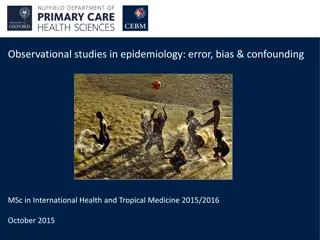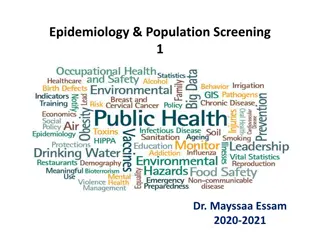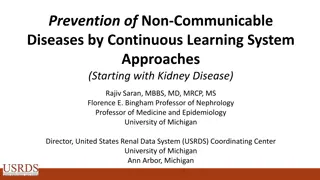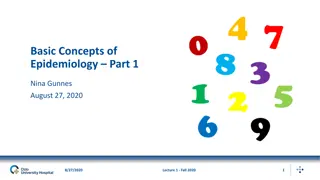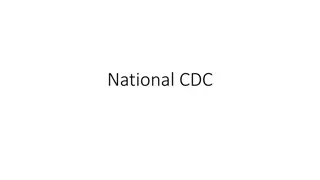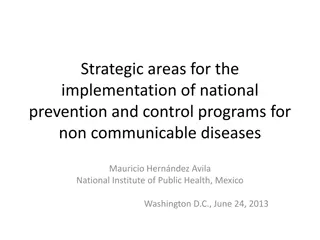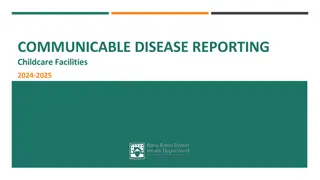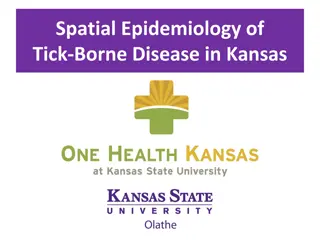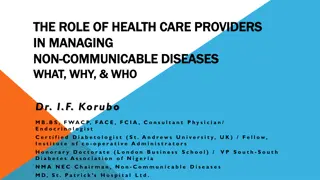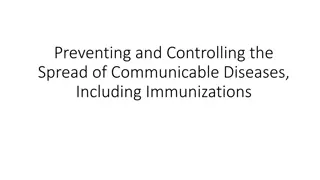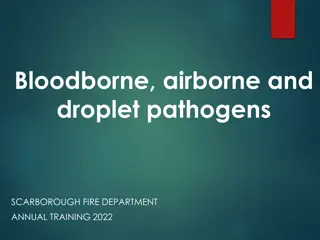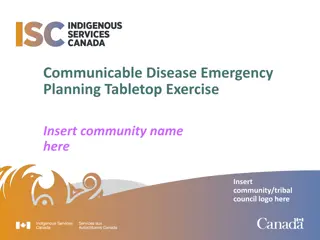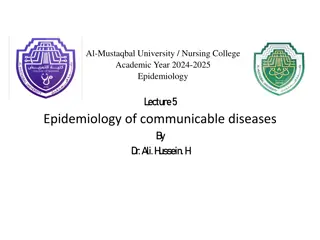Epidemiology of Communicable Diseases 2023-2024 Overview
This presentation highlights the epidemiology of communicable diseases, covering definitions, modes of transmission, and control strategies. It explains communicable diseases, incubation periods, communicable periods, endemic, epidemic, elimination, and eradication concepts.
Download Presentation

Please find below an Image/Link to download the presentation.
The content on the website is provided AS IS for your information and personal use only. It may not be sold, licensed, or shared on other websites without obtaining consent from the author.If you encounter any issues during the download, it is possible that the publisher has removed the file from their server.
You are allowed to download the files provided on this website for personal or commercial use, subject to the condition that they are used lawfully. All files are the property of their respective owners.
The content on the website is provided AS IS for your information and personal use only. It may not be sold, licensed, or shared on other websites without obtaining consent from the author.
E N D
Presentation Transcript
Epidemiology of communicable Epidemiology of communicable diseases diseases L L6 6 . . 2023-2024
Objectives Students have to know about : 1-Definition of basic terms 2- Mode of transmission of communicable diseases 3- General strategies to control communicable disease
Communicable disease A communicable disease may be defined as an illness that arises from transmission of an infectious agent or its toxic product from an infected person, animal, or reservoir to a susceptible host, either directly or indirectly through an intermediate plant or animal host, vector, or environment
Incubation period The interval between exposure and first clinical manifestation. The time between exposure and first case is the minimum incubation period, The time between exposure and the last case, maximum incubation period.
Communicable period Communicable transmission of infectious agent from reservoir to a susceptible host. Reservoir: Any human arthropods, soil or inanimate matter in which an infectious agent normally lives and multiplies and from which it passes to a new host. For example, soil may harbor agents that causes tetanus, anthrax. Some diseases with human reservoirs are: Most bacterial and viral respiratory diseases Period: time period require for beings, animals, plants,
Endemic: when an infectious agent or disease has a constant presence within a defined geographic area Epidemic: occurrences of infectious agent or disease that clearly exceed the usual expected frequency of the disease in a particular population Pandemic worldwide when an epidemic outbreak occurs
Elimination of disease Disease incidence is reduced to a minimal level at which the disease is no longer considered a public health problem, while infection may still occur Example:The aim of elimination of Neonatal tetanus is reduction of its incidence to less than one case/1000 live births. Eradication It means worldwide disappearance of a disease (permanent reduction to zero level) with complete destruction of the agent. The organism can be present only in laboratories and no need for interventions.
The following points explain Why Knowledge of communicable diseases is fundamental to the practice of community health nursing . 1. Communicable diseases typically spread through communities of people. 2. Understanding of the basic concepts of communicable disease control, helps a community health nurse to effectively work to prevent and control communicable disease in populations.
3- It also helps nurses to teach important and effective preventive measures to community members, advocate for those affected, and protect the well-being of uninfected persons (including the nurses themselves).
A person may develop a communicable disease after becoming infected by the pathogen. This may happen through: direct contact with a person carrying the pathogen contact with contaminated fluids, such as blood, mucus, or saliva inhaling contaminated droplets from another person s cough or sneeze receiving a bite from an animal or insect carrying the pathogen consuming contaminated water or foods
Once a pathogen has entered a persons body, it will begin replicating. The individual may then begin to experience symptoms. Some symptoms are a direct result of the pathogen damaging the body s cells. Others are due to the body s immune response to the infection. Communicable diseases are usually mild, and symptoms pass after a few days. However, some can be serious and potentially life threatening.
Mode of transmission: The way disease agents are transmitted from the source of infection to new hosts.
Direct Transmission Direct transmission occurs by immediate transfer of infectious agents from a reservoir to a new host. It requires direct contact with the source, through touching, biting, kissing, or sexual intercourse, or by the direct projection of droplet spray onto the conjunctiva or onto the mucous membranes of the eye, nose, or mouth during sneezing, coughing, spitting, laughing, singing, or talking. Direct transmission is limited to a distance of 1 meter or less.
Methods of Direct mode of transmission 1. Person to person contact The organism spreads by contact with denuded epithelium. Contrary to what people think, most sexually transmitted diseases transmitted by any kind of contact which involves an epithelial breach. can also be
2. Droplets Droplets micro particles of respiratory secretions, which, when coughed or sneezed out, are blasted into air with high velocity and inhaled by anybody nearby. Most respiratory infections tuberculosis) are spread by droplets. Such infections are difficult to control in an overcrowded population like our country. (influenza, diphtheria,
3. Contact with soil The contact may be deliberate (putting soil or cow dung over the cord stumps of newborns, which introduces the tetanus bacilli) or accidental (carrying out deliveries over an unclean surface, which has the same effect); farmers who walk bare feet in open field are infested by hookworms through their feet.
4. Inoculation in anybody fluid This gives the organism the most direct access to circulatory system. For example, hepatitis B and HIV are secreted in all body fluids, and if the body fluids of a patient (blood/ serum/ CF/ saliva/ semen/ vaginal secretion) come in contact with anybody fluid of a healthy person (through epithelial abrasions), he gets infected.
5. Transplacental The blood of fetus and mother are separated throughout the pregnancy except during labor, when the two get mixed, and some organisms can infect the fetus from mothers blood during this period (HIV, hepatitis B). However, some organisms can cross the placental barrier in early pregnancy malformation or abortion (rubella, cytomegalovirus, chickenpox). resulting in fetal
Indirect mode of transmission Indirect transmission implies a stage of external survival of the agent between two hosts, so that it can infect a person sometime after the reservoir is gone from the site. Thus the factors which control indirect transmission are: 1. Viability of the agent How long can it survive without any host to sustain it. 2. Virulence of agent How dangerous can it still remain after the period of external survival. 3. Environment is the environment suitable for survival of the organism.
The methods of indirect transmission are as follows. 1- Vehicle Inanimate objects carrying the organism around (i.e. water, food, blood). Often a vehicle is responsible for a point source epidemic, for example, a certain contaminated water source causing diarrhea in everybody who drank it. The features of such an epidemic are 1. A sudden rise in degree of contamination causes the outbreak. 2. Cases are usually confined to exposed population (nobody who has not drank water from that source falls ill). 3. Secondary cases seldom occur after the primary case are obscured (person to person infection does not usually take place).
4. May spread over wide distance (as people go to their homes after exposure). 5. Isolation of agent from the vehicle is not always possible. 6. Epidemic dwindles if the vehicle is withdrawn. 7. Common source of infection (i.e. the contaminated water source) is usually traceable from history of the cases.
2- Vectors An intermediate organism which transports a micro- organism between two hosts. Examples include Man mosquitoes man (malaria) Rat flea man (plague) Man sand fly man (kala-azar). Mechanical vectors: carry the agent, and are in no way essential for the organism to carry out its life cycle, e,g flies are mechanical vectors. Biological vectors :harbor a part of the life cycle of organism inside them, rather than just carry it.
3-Airborne route A -Airborne transmission occurs through droplet nuclei the small residues that result from evaporation of fluid from droplets emitted by an infected host. Because of their small size and weight, they can remain suspended in the air for long periods before they are inhaled into the respiratory system of a host . Example The dried sputum of a tuberculosis patient remains infective long after the patient is gone, because the bacilli survive the desiccation and begin to float freely in air in microparticles (nuclei) of sputum.
B .Airborne transmission can also occur in dust Small particles of dust from soil containing fungus spores may cling to clothing, bedding, or floors. Alternatively, the spores may become separated from dry soil by the wind and then be inhaled by the host..
4- Fomites Fomites are any inanimate object except food and water (like clothes, utensils and personal belongings of a patient) that bear germs and spread the disease. Suppose you have caught a cold and you sneeze into your towel when taking a bath. The virus which are deposited in the towel, if they manage to live long enough, will infect the next person who uses the towel.
5- Fingers The importance of clean hands can not be overstated, specially after the swine influenza epidemic. Most eye infections are hand to mouth, i.e. you have conjunctivitis you rub your eyes your hands get soaked with virus you handshake with someone he touches his eyes (for no particular reason, just because of habit) he gets conjunctivitis.
Carrier: An infected person who harbors a specific infectious agent in the absence of clinical features. It acts as a source of infection to others. Carriers may be incubatory, convalesce or chronic. Three elements have to occur leading to the carrier state: The presence of the disease agent in the body. The absence of recognizable symptoms and signs of disease. The shedding of disease agent in the discharge or excretions.
The general strategies to control communicable diseases: 1. Elimination of source of infection by effective detection and treatment dealing with any other source. 2. Interruption of transmission path ways, for example by the destruction of intermediate hosts, destruction of breeding sites and purification of water. 3. Improvement of host resistance or immunity against infection as for example by immunization of cases and carriers or
Quiz 1- Enumerate the Mode of transmission of communicable diseases 2- Define the indirect mode of transmission of disease and enumerate factors, which control the indirect transmission. 3-Define the carrier of disease and what are elements that have to occur leading to the carrier state. 4-General strategies to control communicable disease



